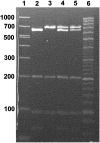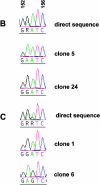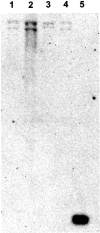Multiple copies of the 16S rRNA gene in Nocardia nova isolates and implications for sequence-based identification procedures
- PMID: 15956412
- PMCID: PMC1151890
- DOI: 10.1128/JCM.43.6.2881-2885.2005
Multiple copies of the 16S rRNA gene in Nocardia nova isolates and implications for sequence-based identification procedures
Abstract
Molecular investigation of two Nocardia patient isolates showed unusual restriction fragment length polymorphism patterns with restriction endonuclease assays (REA) using an amplified portion of the 16S rRNA gene. Patterns typical of Nocardia nova were obtained with REA of an amplified portion of the 65-kDa heat shock protein gene. Subsequent sequence analysis of the 16S rRNA gene regions of these isolates showed the presence of ambiguous bases within an expected restriction endonuclease recognition site which were not able to be resolved on repeat testing. Cloning of amplified regions of the 16S rRNA genes and subsequent sequencing of the resulting clones from the two patient isolates showed three different 16S rRNA gene sequences which corresponded to sequences found in N. nova, a molecular variant of N. nova, and a previously undescribed sequence. Hybridization studies using a DNA probe corresponding to an 89-bp conserved region of the 16S rRNA gene confirmed the presence of at least two copies of the 16S rRNA gene in the N. nova type strain, in a patient isolate identical to the molecular variant of N. nova, and in the two other patient isolates. All isolates were found to belong to the species N. nova as determined by DNA-DNA hybridization. Because minimal variation has been found in the 16S rRNA gene sequences of different species of Nocardia, those laboratories employing molecular methods for identification of these species must be aware of the potential identification complications that may be caused by the presence of differing 16S rRNA genes in the same isolate.
Figures



References
-
- Bercovier, H., O. Kafri, and S. Sela. 1986. Mycobacteria possess a surprisingly small number of ribosomal RNA genes in relation to the size of their genome. Biochem. Biophys. Res. Commun. 136:1136-1141. - PubMed
-
- Brenner, D. J., F. W. Hickman-Brenner, J. V. Lee, A. G. Steigerwalt, G. R. Fanning, D. G. Hollis, J. J. Farmer III, R. E. Weaver, S. W. Joseph, and R. Seidler. 1983. Vibrio furnissii (formerly aerogenic biogroup of Vibrio fluvialis), a new species isolated from human feces and the environment. J. Clin. Microbiol. 18:816-824. - PMC - PubMed
-
- Brown, J. M., and M. M. McNeil. 2003. Nocardia, Rhodococcus, Gordonia, Actinomadura, Streptomyces, and other aerobic actinomycetes, p. 502-531. In P. R. Murray et al. (ed.), Manual of clinical microbiology, 8th ed., vol. 1. ASM Press, Washington, D.C.
-
- Cilia, V., B. Lafay, and R. Christen. 1996. Sequence heterogeneities among 16S ribosomal RNA sequences, and their effect on phylogenetic analyses at the species level. Mol. Biol. Evol. 13:451-461. - PubMed
MeSH terms
Substances
LinkOut - more resources
Full Text Sources

